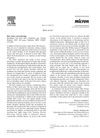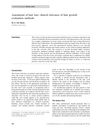Hair Cycle and Hair Pigmentation: Dynamic Interactions and Changes Associated with Aging
December 2003
in “
Micron
”
hair cycle hair pigmentation aging hair follicle pigment production gray hair white hair tyrosinase activity melanocytes hair bulb keratinocytes DNA damage reactive oxygen species antioxidant factors apoptotic factors hair graying hair follicle melanocytes hair color gray hair white hair hair graying hair color
TLDR As people age, their hair follicles produce less pigment, leading to gray and white hair, due to factors like reduced enzyme activity and damage to melanocyte DNA.
The document discussed the dynamic interactions between hair cycle and pigmentation, particularly focusing on changes associated with aging. It highlighted that hair color is determined by melanins, and the aging process affects melanocyte activity, leading to hair graying and loss. The study noted that hair loss during aging is common but varies by individual, and while treatments like finasteride have shown some effectiveness in aging males, results in females are less conclusive. The document also mentioned the controversial link between long-term use of hair dyes and cancer risk, and the potential for reversing canities and hair loss through various treatments, though results are inconsistent.








